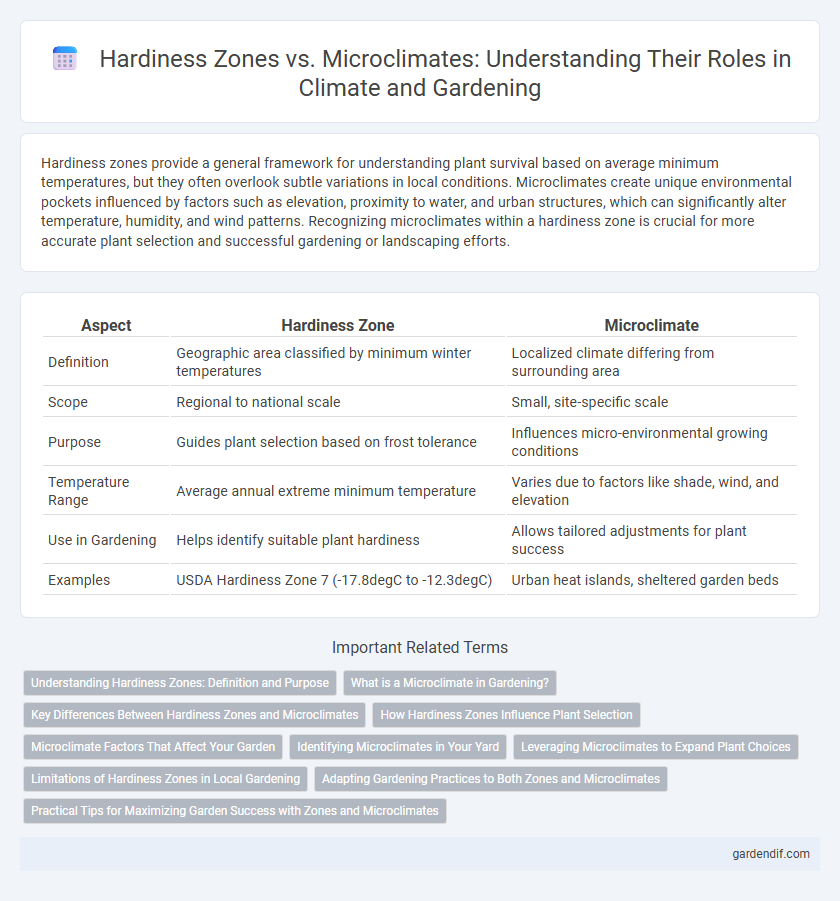
Hardiness zone vs microclimate Illustration
Hardiness zones provide a general framework for understanding plant survival based on average minimum temperatures, but they often overlook subtle variations in local conditions. Microclimates create unique environmental pockets influenced by factors such as elevation, proximity to water, and urban structures, which can significantly alter temperature, humidity, and wind patterns. Recognizing microclimates within a hardiness zone is crucial for more accurate plant selection and successful gardening or landscaping efforts.
Table of Comparison
| Aspect | Hardiness Zone | Microclimate |
|---|---|---|
| Definition | Geographic area classified by minimum winter temperatures | Localized climate differing from surrounding area |
| Scope | Regional to national scale | Small, site-specific scale |
| Purpose | Guides plant selection based on frost tolerance | Influences micro-environmental growing conditions |
| Temperature Range | Average annual extreme minimum temperature | Varies due to factors like shade, wind, and elevation |
| Use in Gardening | Helps identify suitable plant hardiness | Allows tailored adjustments for plant success |
| Examples | USDA Hardiness Zone 7 (-17.8degC to -12.3degC) | Urban heat islands, sheltered garden beds |
Understanding Hardiness Zones: Definition and Purpose
Hardiness zones classify geographic areas based on average annual minimum temperatures to guide plant selection and cultivation. These zones help gardeners and landscapers understand which plants can survive winter conditions in specific regions. Microclimates, however, create localized variations in temperature and humidity that may differ significantly from the broader hardiness zone classification.
What is a Microclimate in Gardening?
A microclimate in gardening refers to the unique climate conditions that exist in a specific, localized area, differing from the surrounding regional climate and hardiness zone. These variations can be influenced by factors such as elevation, proximity to water, urban heat islands, and soil composition, which affect temperature, humidity, wind exposure, and sunlight. Understanding microclimates allows gardeners to select plants better suited for these specific conditions, improving growth and resilience beyond the general guidelines provided by USDA Hardiness Zones.
Key Differences Between Hardiness Zones and Microclimates
Hardiness zones classify regions based on average minimum winter temperatures, providing a broad guideline for plant survival, while microclimates refer to localized atmospheric conditions influenced by factors such as elevation, water bodies, and urban structures. Hardiness zones offer a general planting framework across large geographic areas, whereas microclimates create unique environmental niches that can significantly differ even within the same hardiness zone. Understanding these key differences allows gardeners and landscapers to select plants better suited to both regional climate averages and specific local conditions.
How Hardiness Zones Influence Plant Selection
Hardiness zones provide a general guideline for plant selection by categorizing regions based on average minimum winter temperatures, helping gardeners choose plants suited to their climate. Microclimates, however, create localized variations in temperature, moisture, and sunlight that can allow species outside a given hardiness zone to thrive. Understanding both hardiness zones and microclimates enables more precise plant selection, maximizing growth potential and survival in diverse environmental conditions.
Microclimate Factors That Affect Your Garden
Microclimate factors such as sunlight exposure, soil composition, wind patterns, and proximity to water bodies significantly influence garden conditions beyond the general Hardiness Zone classification. These localized elements create variations in temperature and moisture levels, enabling plants to thrive in areas that may not align precisely with their USDA zone recommendations. Understanding and leveraging microclimates can optimize plant selection and improve garden resilience against climate fluctuations.
Identifying Microclimates in Your Yard
Hardiness zones categorize regions based on average minimum winter temperatures, providing a general guide for plant survival. Microclimates within your yard can vary significantly due to factors like sun exposure, wind protection, soil type, and elevation, affecting local temperature and moisture levels. Identifying these microclimates by observing plant health patterns and temperature variations allows for more precise gardening decisions beyond standard hardiness zone recommendations.
Leveraging Microclimates to Expand Plant Choices
Hardiness zones provide a general guideline for plant survival based on average minimum temperatures, while microclimates offer localized variations in temperature, moisture, and sunlight that can significantly alter growing conditions. By understanding and leveraging microclimates--such as south-facing slopes, sheltered garden corners, or urban heat islands--gardeners can successfully cultivate a wider variety of plants beyond their hardiness zone recommendations. This strategic use of microclimates enhances biodiversity and extends growing seasons, optimizing plant health and garden productivity.
Limitations of Hardiness Zones in Local Gardening
Hardiness zones provide a general guideline based on average minimum winter temperatures but often fail to account for the diverse microclimates within a single garden. Factors such as soil type, sun exposure, wind patterns, and urban heat islands dramatically influence plant survival and growth beyond the simplistic zone classification. Gardeners must assess these localized environmental variables to optimize plant selection, ensuring more accurate predictions than relying solely on hardiness zone maps.
Adapting Gardening Practices to Both Zones and Microclimates
Understanding hardiness zones provides a general guide to plant survival based on minimum temperatures, while microclimates reflect localized variations such as sun exposure, wind patterns, and shade. Adapting gardening practices requires selecting plants suited to both the broader zone's climate parameters and the specific microclimate conditions in your garden. Techniques like amending soil, adjusting planting locations, and using protective measures can optimize growth and resilience in diverse environmental pockets within the same hardiness zone.
Practical Tips for Maximizing Garden Success with Zones and Microclimates
Understanding hardiness zones provides a baseline for plant survival based on average minimum temperatures, while recognizing microclimates allows gardeners to exploit localized variations such as sunlight exposure, wind patterns, and soil conditions. To maximize garden success, position sensitive plants in warmer microclimates near walls or sheltered areas and use mulch or frost cloths to modify temperature extremes. Monitoring soil moisture and adjusting planting times according to microclimate shifts further enhances plant resilience within designated hardiness zones.
Hardiness zone vs microclimate Infographic

 gardendif.com
gardendif.com